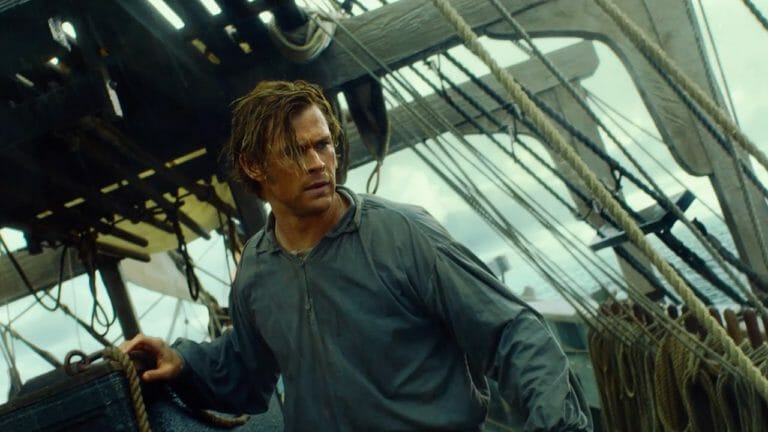By Nguyen Le · December 22, 2015

Amidst the crowded, stormy waters of the holiday season comes Ron Howard's latest, In The Heart of The Sea, based on Nathaniel Philbrick’s award-
And, holy cow, what a demon this film has. Through gorgeous rendering by the team at Double Negative and Howard’s fast-paced direction, the whale that brought down the Essex is unstoppable, vengeful and ready to die with if it means bringing down its hunters with it. Possessing a collection of fleshy blemishes (mostly from man in addition to, presumably, other marine predators) and enough presence to send other whales scurrying, the monster that inspired Moby-Dick is a true determinant of one’s bravado and experience.
The world of In the Heart of the Sea is a sight to behold as well, and what else could it be with cinematography by Anthony DodMantle? Similar to Rush, the cinematographer dresses the film with a sleek vintage sheen boosting appropriate colors to reflect the era. While the aesthetics of the Lauda-Hunt story resembled the vivid hand-drawn racing
Behind all the bells and whistles, however, In the Heart of the Sea shows an unfortunate lack of narrative focus. It's hard to say why Howard and his go-to editors, Daniel P. Henley and Mike Hill, fail to differentiate between the frenetic and the serene in the film's pacing – a feat accomplished so wonderfully in A Beautiful Mind. Granted, the frenzied cutting sublimely conveys the thrill of the chase, but “whales” and “1822” warrants more restraint over Grand Prix in the 70s. Also fleeting are a handful of performances, which is a waste because Cillian Murphy and Benjamin Walker have been under the radar for so long already. The major hitters, however, are Tom Holland – who will soon headline as Spider-Man – and Chris Hemsworth – who truly deserves a chance to upend his omnipresent image as Thor.
But the most lost-at-sea aspect of Sea is Charles Leavitt’s screenplay. The framing device, Melville coming to Nickerson to make progress on his novel “The Whale,” is fine, but like the promotional materials the animal gets placed on the forefront when it should have been the man (or in this case, men). The perspective is problematic, too: though audiences learn the story through Nickerson, the film spends most time on Hemsworth’s Owen Chase and his rift with Walker’s Captain George Pollard Jr. From this rivalry stems commentaries on the value of one’s name and how the product is worthier than the producer, both of which could have been addressed with less screen-time.
Leavitt seems to have misinterpreted the novel’s core: survival. Humans against the world. The film should have been most affecting when the crew finds themselves stranded on an island, but time spent here is too short to bear significance.
Ultimately, In the Heart of the Sea is an underwhelming trip despite its majestic setup. The film could have been more, given the talent involved, but tough it is to control a ship with a poorly-designed rudder.